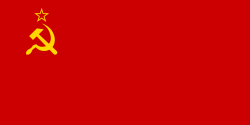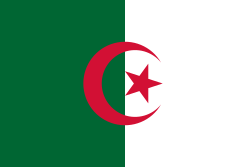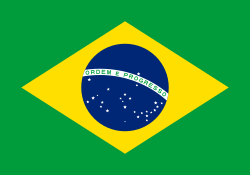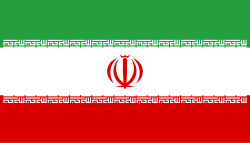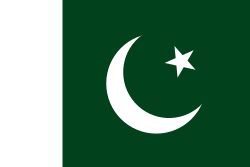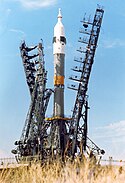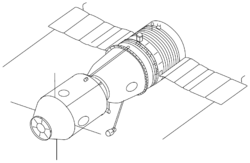Sojuzprogrammet
- För andra betydelser, se Sojuz.
| Sojuzprogrammet | |
 Sojuz TMA | |
| Land | Sovjetunionen, Ryssland |
|---|---|
| Organisation | Sovjetunionens rymdprogram (1966–1991) Roskosmos (1991-) |
| Status | Pågår |
| Historik | |
| Första bemannade rymdfärd | Sojuz 1 |
| Plats(er) för uppskjutning | Bajkonur |
| Farkostinformation | |
| Bemannad(e) farkost(er) | Sojuz |
| Besättningskapacitet | 1-3 |
| Raket(er) | Sojuz |

Sojuzprogrammet var Sovjetunionens bemannade rymdfarkoster med tredje generations rymdfarkoster. Programmet togs över av Ryssland 1991 när Sovjetunionen upplöstes.
Som bärraket använder man en raket vid namn Sojuz. Raketen är en vidareutveckling av Vostokraketen, som användes i Vostokprogrammet.
Under Sojuzprogrammet har man använt sig av sex typer av farkoster. Första farkosterna sköts upp under 1960-talet och har sedan dess utvecklats till nya och mer anpassade till dagens verksamhet med dockningar till den internationella rymdstationen ISS.
Tre saker har alla Sojuzvarianter gemensamt:
- En sfärisk omloppsmodul.
- En liten aerodynamisk återinträdeskapsel.
- En cylindrisk servicemodul med solpaneler.
Sojuzfarkosterna användes från 1970-talets början till rymdstationerna i Saljut-serien och sedermera Mir. Sojuz skjuts upp från kosmodromen i Bajkonur i Kazakstan.
Den 17 juli 1975 skrevs rymdhistoria då en Sojuzfarkost och en Apollofarkost dockade med varandra för första gången. Detta var första gången rymdfarkoster från de två länderna dockade med varandra och kan ses som slutet på rymdkapplöpningen.
Obemannade
- Kosmos 133
- Uppskjutning misslyckad
- Kosmos 140
- Kosmos 186 (första dockning)
- Kosmos 188 (första dockning)
- Kosmos 212
- Kosmos 213
- Kosmos 238
- Sojuz 2
- Kosmos 396
- Kosmos 496
- Kosmos 573
- Kosmos 613
- Kosmos 638
- Kosmos 656
- Kosmos 670
- Kosmos 672
- Sojuz 20 (dockade med Saljut 4)
- Kosmos 772
- Kosmos 869
- Kosmos 1001
- Kosmos 1074
- Sojuz T-1
- Sojuz TM-1
- Sojuz MS-14
Bemannade
Sojuz
- Sojuz 1 (besättningen omkom)
- Sojuz 3
- Sojuz 4 (första dockning)
- Sojuz 5 (första dockning)
- Sojuz 6
- Sojuz 7
- Sojuz 8
- Sojuz 9
- Sojuz 10
- Sojuz 11 (besättningen omkom)
- Sojuz 12
- Sojuz 13
- Sojuz 14 (första till Saljut 3)
- Sojuz 15 (sista till Saljut 3)
- Sojuz 16
- Sojuz 17 (första till Saljut 4)
- Sojuz 18a (misslyckad uppskjutning)
- Sojuz 18 (sista till Saljut 4)
- Sojuz 19 (Apollo-Sojuz-testprojektet)
- Sojuz 21 (första till Saljut 5)
- Sojuz 22
- Sojuz 23
- Sojuz 24 (sista till Saljut 5)
- Sojuz 25 (första till Saljut 6)
- Sojuz 26
- Sojuz 27
- Sojuz 28
- Sojuz 29
- Sojuz 30
- Sojuz 31
- Sojuz 32 (obemannad landning)
- Sojuz 33
- Sojuz 34 (obemannad uppskjutning)
- Sojuz 35
- Sojuz 36
- Sojuz 37
- Sojuz 38
- Sojuz 39
- Sojuz 40 (sista till Saljut 6)
Sojuz T
16 december 1979 – 16 juli 1986
- Sojuz T-2
- Sojuz T-3
- Sojuz T-4
- Sojuz T-5 (första till Saljut 7)
- Sojuz T-6
- Sojuz T-7
- Sojuz T-8
- Sojuz T-9
- Sojuz T-10-1 (misslyckad uppskjutning)
- Sojuz T-10
- Sojuz T-11
- Sojuz T-12
- Sojuz T-13
- Sojuz T-14
- Sojuz T-15 (första till Mir och sista till Saljut 7)
Sojuz TM
- Sojuz TM-2
- Sojuz TM-3
- Sojuz TM-4
- Sojuz TM-5
- Sojuz TM-6
- Sojuz TM-7
- Sojuz TM-8
- Sojuz TM-9
- Sojuz TM-10
- Sojuz TM-11
- Sojuz TM-12
- Sojuz TM-13
- Sojuz TM-14
- Sojuz TM-15
- Sojuz TM-16
- Sojuz TM-17
- Sojuz TM-18
- Sojuz TM-19
- Sojuz TM-20
- Sojuz TM-21
- Sojuz TM-22
- Sojuz TM-23
- Sojuz TM-24
- Sojuz TM-25
- Sojuz TM-26
- Sojuz TM-27
- Sojuz TM-28
- Sojuz TM-29
- Sojuz TM-30 (sista till Mir)
- Sojuz TM-31 (första till ISS)
- Sojuz TM-32 (världens första rymdturist)
- Sojuz TM-33
- Sojuz TM-34 (världens andra rymdturist)
Sojuz TMA
30 oktober 2002 – 27 april 2012
Sojuz TMA-M
7 oktober 2010 – 7 september 2016
Sojuz MS
- Sojuz MS-01
- Sojuz MS-02
- Sojuz MS-03
- Sojuz MS-04
- Sojuz MS-05
- Sojuz MS-06
- Sojuz MS-07
- Sojuz MS-08
- Sojuz MS-09
- Sojuz MS-10 (misslyckad uppskjutning)
- Sojuz MS-11
- Sojuz MS-12
- Sojuz MS-13
- Sojuz MS-15
- Sojuz MS-16
- Sojuz MS-17
- Sojuz MS-18
- Sojuz MS-19
- Sojuz MS-20
- Sojuz MS-21
- Sojuz MS-22
- Sojuz MS-23
- Sojuz MS-24
- Sojuz MS-25
- Sojuz MS-26
- Sojuz MS-27
- Sojuz MS-28
- Sojuz MS-29
- Sojuz MS-30
Se även
Externa länkar
 Wikimedia Commons har media som rör Sojuzprogrammet.
Wikimedia Commons har media som rör Sojuzprogrammet.
Källor
- Den här artikeln är helt eller delvis baserad på material från engelskspråkiga Wikipedia, Soyuz programme, 8 april 2008.
| |||||||||||||||||||||||||||||||||||||||||||||||||||||||||||||||||||||||||||||||||||||||||
| ||||||||||||||||||||||
Media som används på denna webbplats
A replica of Sputnik 1, the first artificial satellite in the world to be put into outer space: the replica is stored in the National Air and Space Museum.
MAVEN at Mars, Artist's Concept. This artist's concept depicts NASA's Mars Atmosphere and Volatile EvolutioN (MAVEN) spacecraft near Mars. MAVEN is in development for launch in 2013 and will be the first mission devoted to understanding the Martian upper atmosphere. The mission's principal investigator is Bruce Jakosky from the Laboratory for Atmospheric and Space Physics at the University of Colorado.
The goal of MAVEN is to determine the role that loss of atmospheric gas to space played in changing the Martian climate through time. MAVEN will determine how much of the Martian atmosphere has been lost over time by measuring the current rate of escape to space and gathering enough information about the relevant processes to allow extrapolation backward in time.
NASA Goddard Space Flight Center in Greenbelt, Md. manages the project and will also build some of the instruments for the mission. In addition to the principal investigator coming from CU-LASP, the university will provide science operations, build instruments, and lead education/public outreach. Lockheed Martin of Littleton, Colo., is building the spacecraft and will perform mission operations. The University of California-Berkeley Space Sciences Laboratory is also building instruments for the mission. NASA's Jet Propulsion Laboratory, Pasadena, Calif., will provide navigation support, the Deep Space Network, and the Electra telecommunications relay hardware and operations.
For more information about MAVEN, visit www.nasa.gov/maven.The Flag of Europe is the flag and emblem of the European Union (EU) and Council of Europe (CoE). It consists of a circle of 12 golden (yellow) stars on a blue background. It was created in 1955 by the CoE and adopted by the EU, then the European Communities, in the 1980s.
The CoE and EU are distinct in membership and nature. The CoE is a 47-member international organisation dealing with human rights and rule of law, while the EU is a quasi-federal union of 27 states focused on economic integration and political cooperation. Today, the flag is mostly associated with the latter.
It was the intention of the CoE that the flag should come to represent Europe as a whole, and since its adoption the membership of the CoE covers nearly the entire continent. This is why the EU adopted the same flag. The flag has been used to represent Europe in sporting events and as a pro-democracy banner outside the Union.bendera Indonesia
Flag of Iran. The tricolor flag was introduced in 1906, but after the Islamic Revolution of 1979 the Arabic words 'Allahu akbar' ('God is great'), written in the Kufic script of the Qur'an and repeated 22 times, were added to the red and green strips where they border the white central strip and in the middle is the emblem of Iran (which is a stylized Persian alphabet of the Arabic word Allah ("God")).
The official ISIRI standard (translation at FotW) gives two slightly different methods of construction for the flag: a compass-and-straightedge construction used for File:Flag of Iran (official).svg, and a "simplified" construction sheet with rational numbers used for this file.
Flag of Israel. Shows a Magen David (“Shield of David”) between two stripes. The Shield of David is a traditional Jewish symbol. The stripes symbolize a Jewish prayer shawl (tallit).
Soyuz 18 booster on the launch pad 1 at the Baikonur complex in Kazakhstan, USSR.
Soyuz-TM spacecraft. Compare the antennas on the orbital module to those on Soyuz-T. Differences reflect the change from the Igla rendezvous system used on Soyuz-T to the Kurs rendezvous system used on Soyuz-TM.
Apollo-Soyuz Test Project (ASTP) Soyuz. The APAS-75 docking unit is located at left.
The Soyuz TMA-04M spacecraft is seen after being rolled out by train to the launch pad at the Baikonur Cosmodrome in Kazakhstan, May 13, 2012. The launch of the Soyuz spacecraft, with Expedition 31 Soyuz Commander Gennady Padalka, Flight Engineer Sergei Revin of Russia and NASA Flight Engineer Joe Acaba, is scheduled for 9:01 a.m., May 15 (Kazakhstan time).
Backdropped by a blue and white Earth, this close-up view features the Soyuz TMA-6 spacecraft approaching the International Space Station (ISS). Onboard the spacecraft are cosmonaut Sergei K. Krikalev, Expedition 11 commander representing Russia's Federal Space Agency; astronaut John L. Phillips, NASA ISS science officer and flight engineer; and European Space Agency (ESA) astronaut Roberto Vittori of Italy. The Soyuz linked to the Pirs Docking Compartment at 9:20 p.m. (CDT) on April 16, 2005 as the two spacecraft flew over eastern Asia. The docking followed Friday’s launch from the Baikonur Cosmodrome in Kazakhstan.
Soyuz-A manned spacecraft concept (1963). It was to have been part of the Soyuz A-B-C circumlunar complex.






